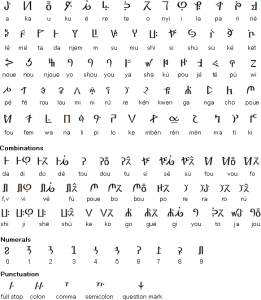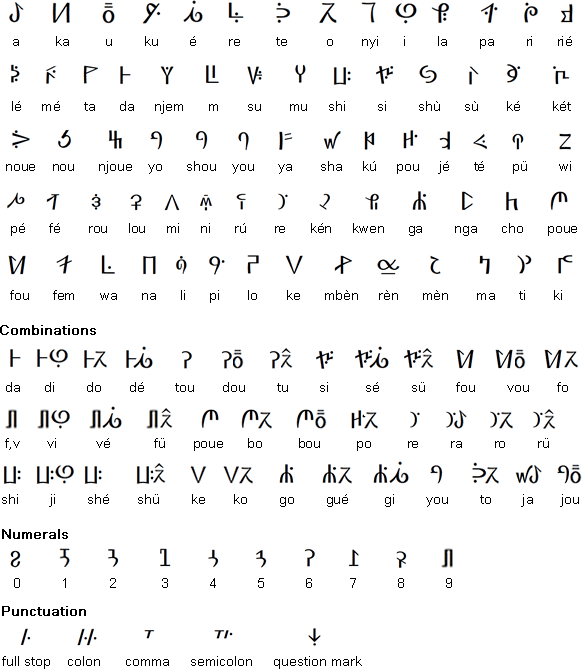A tragic tale, a hopeful future
 Some amazing news. Thanks to the help of Dan Kaufman of the Endangered Language Alliance, I’ve finally managed to contact someone who knows Bamum.
Some amazing news. Thanks to the help of Dan Kaufman of the Endangered Language Alliance, I’ve finally managed to contact someone who knows Bamum.
Here’s the backstory. I’ve been looking for someone who can read and write Bamum, a script from one of the many districts of Cameroon, ever since I started the Alphabets more than five years ago, and my book Endangered Alphabets was dedicated to King Ibrahim Njoya of the Bamum people for reasons I’ll now explain.
Like most kingdoms in colonial Africa, the official writing system of Bamum was the Latin alphabet of the European colonists–until around 1895. At that point King Njoya sent word out to his people that he planned to create a script specifically for their language, Shupamem, using their help.
He asked for them to send him what we might call icons–in other words, glyphs and images, perhaps taken from traditional weaving or pottery designs, perhaps entirely novel shapes–that would serve as letter symbols. In other words, not only was this not a European invention, but it consisted of images familiar to the people who would use it.
By 1903 he had collected some 465 symbols and whittled them down to 73. The administrative map of the kingdom and an impressive amount of administrative records and legal codes were archived using the Bamum scripts. The king created schools in Foumban (the capital of the Bamum Kingdom) and other surrounding towns to teach the writing system and Shupamem to the community. The writing system was used to keep the record of the history of the kingdom, and to write recipes for traditional medicine, cartography, personal correspondence, many folktales and the genealogy of the Kingdom.
The king also collected numerous manuscripts containing the history of his people, and used his script to compile a pharmacopoeia, to design a calendar, and to keep records and for law. He also built schools, libraries and set up a printing press.
All was well while Cameroon was under German colonial control, but at the end of World War I the French took over the country. The French colonial authorities destroyed the libraries and the printing press, many of the books in the Bamum script were destroyed, and the teaching of the script in schools was banned. King Njoya was driven into exile, where he died.
After Cameroon became independent in 1960, Nyoja’s son and heir, Seidou Njimoluh, collected such Bamum manuscripts and other materials that survived and put them in his father’s museum. Even so, nowadays the script is in such decline that according to the leading scholar of the subject only one man, a traditional healer, uses the Bamum script as his first and only means of writing.
King Njoya’s astonishingly far-sighted and surprisingly populist actions led me to dedicate my book to him. But I couldn’t find anyone who can speak Shupramem, the Bamum language, or write its script until two days ago, when I started corresponding with Dr. Abdoulaye Laziz Nchare, a Cameroonian linguist living in New York.
These are early days, but I’m hoping to carve some proverbs in Bamum, to contribute to a conference Dr Nchare is planning, and to play the same kind of role I (and other members of the Alphabets team) have been playing in the Chittagong Hill Tracts of Bangladesh.
If you’d like to help, or know anyone who might help, don’t hesitate to contact me through this website!
Tim


December 3, 2015 @ 10:48 pm
I’ve worked with Dr. Konrad Tuchscherer, Michael Everson and Oumarou Nchare on encoding the Bamum script into Unicode, beginning with field research in 2006. It would be great to be kept up on how the planning for a conference will evolve.
Charles L. Riley
October 27, 2022 @ 12:46 pm
I am looking for bamoun script datasets.